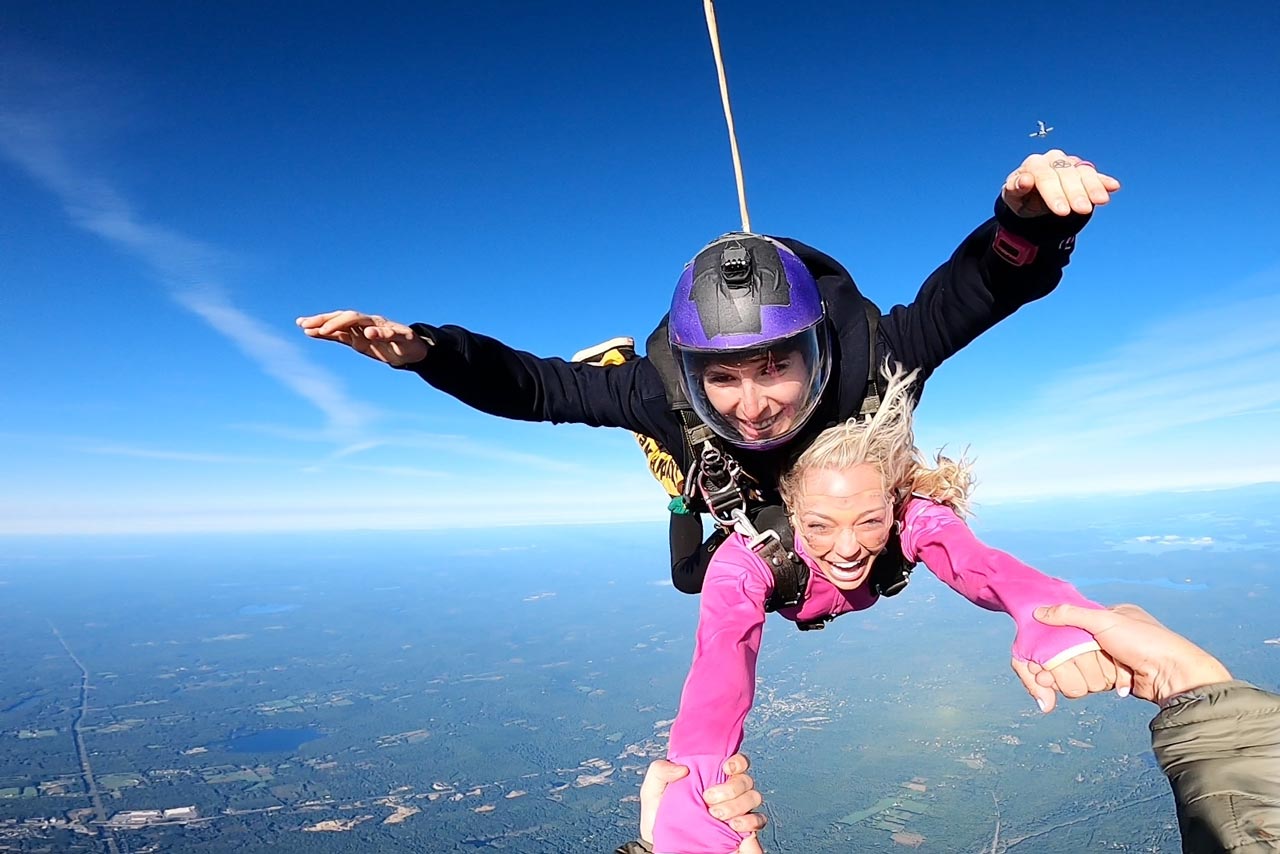
Skydiving is an exhilarating activity that has captured the hearts of adventure enthusiasts worldwide. The sheer thrill of leaping out of a plane and free-falling through the sky is unmatched. While many people are familiar with the concept of skydiving, there are several extraordinary facts about this adrenaline-pumping sport that might surprise you. From the history of skydiving to record-breaking feats, there is a wealth of information to discover about this daring pursuit. In this article, we will delve into 13 extraordinary facts about skydiving that will leave you in awe of the human spirit and the desire for exploration. So buckle up (or rather, buckle in) as we delve into the fascinating world of skydiving!
Key Takeaways:
- Skydiving has a rich history dating back to the 18th century, with extraordinary records like the highest jump from the edge of space and the youngest solo skydiver at 4 years old.
- Skydiving offers pure freedom and can help overcome fears, burn calories, and create a sense of inclusivity, making it an exhilarating and life-changing experience for all.
Skydiving dates back to the 18th century
Yes, skydiving has a history that stretches back over 200 years. The first recorded skydive was performed by Andre-Jacques Garnerin in He used a silk parachute to safely descend from a hot air balloon.
The highest skydive ever recorded was from the edge of space
Felix Baumgartner, an Austrian skydiver, broke the record for the highest skydive in He jumped from a height of 24 miles (39 kilometers) above the Earth’s surface, reaching a speed of over 843 miles per hour during his descent.
Skydiving can be a cure for acrophobia
Believe it or not, skydiving has helped many people overcome their fear of heights. The adrenaline rush and sense of accomplishment achieved from skydiving can be a life-changing experience for individuals suffering from acrophobia.
The average freefall time in skydiving is about 60 seconds
During a typical skydive, the freefall phase lasts for approximately 60 seconds. This is the time when skydivers experience the exhilarating feeling of falling through the air before deploying their parachutes.
You can skydive with a disability
Skydiving is an inclusive sport, and there are specialized equipment and trained instructors available to accommodate individuals with disabilities. It allows people of all abilities to experience the thrill of freefall.
Skydiving can help you burn calories
Did you know that a single skydiving jump can burn up to 500 calories? The freefall and parachute descent require significant energy expenditure, making skydiving not just an exhilarating experience but also a potential fitness activity.
The first female skydiver was Jeanne Geneviève Labrosse
In 1799, Jeanne Geneviève Labrosse became the first woman to successfully parachute from a hot air balloon. Her daring feat paved the way for women to participate in the exhilarating world of skydiving.
Skydiving is safer than you think
Contrary to popular belief, skydiving has become much safer over the years, thanks to advanced equipment, stricter safety regulations, and rigorous training programs. The risk of a fatal injury during a skydive is extremely low.
The youngest person to skydive solo was 4 years old
In 2019, a 4-year-old girl named Lea became the youngest person to skydive solo. Accompanied by a trained instructor, Lea completed a safe and controlled freefall from 13,000 feet, setting a remarkable record.
Skydiving has its own unique vocabulary
Like any other specialized activity, skydiving has its own lingo. Words like “drop zone,” “canopy,” “tracking,” and “formation skydiving” are commonly used among skydivers to describe specific techniques, maneuvers, and locations.
The first parachute jump from an airplane was performed in 1912
In 1912, Albert Berry made history by performing the first successful parachute jump from an airplane. His bravery and pioneering spirit opened up a new era for aviation and skydiving as we know it today.
Skydiving can be a team sport
Skydiving is not only an individual sport but also a team activity. Formations, known as “skydiving formations” or “skydiving formations,” involve a group of skydivers joining together to create patterns and shapes while in freefall.
The sensation of skydiving is often described as “pure freedom”
Ask any experienced skydiver, and they will tell you that the sensation of freefalling through the air is like nothing else. The feeling of pure freedom, weightlessness, and the rush of adrenaline combine to create an unparalleled experience.
So there you have it, the 13 extraordinary facts about skydiving. Whether you’re a seasoned skydiver or someone just curious about the sport, skydiving offers an unparalleled thrill and an opportunity to push your limits. So, if you’re ready to defy gravity and experience the rush of pure freedom, why not give skydiving a try?
Conclusion
Skydiving is an incredible and adrenaline-pumping activity that offers a unique perspective on the world. As we explored in this article, there are a multitude of extraordinary facts about skydiving that showcase its popularity and allure. From its origins in the military to the advancements in equipment and safety measures, skydiving has come a long way since its inception.
Whether you’re an experienced skydiver or someone considering taking the leap for the first time, understanding these facts can enhance your appreciation for this extreme sport. From the breathtaking views to the feeling of weightlessness, skydiving offers an unparalleled thrill that is hard to replicate in any other activity. So, if you’re ready to experience the exhilaration of freefalling and soaring through the sky, why not give skydiving a try?
FAQs
1. Is skydiving safe?
Skydiving is generally considered to be a safe activity when proper precautions are taken. Skydiving centers adhere to strict safety protocols, and instructors are highly trained professionals.
2. How much does skydiving cost?
The cost of skydiving can vary depending on the location and the type of jump you choose. Tandem jumps, where you are harnessed to an instructor, usually range from $200 to $300.
3. Is there an age limit for skydiving?
Most skydiving centers require participants to be at least 18 years old. However, some centers may have age restrictions or require parental consent for younger individuals.
4. Can anyone skydive, regardless of fitness level?
While skydiving does require a certain level of physical fitness, it is a sport that can be enjoyed by people of various fitness levels. However, individuals with certain medical conditions may be advised against skydiving.
5. Do I need any prior experience to skydive?
No prior experience is necessary to go skydiving. Tandem jumps, where you are attached to an experienced instructor, are a popular option for first-time skydivers.
6. Are there any weight restrictions for skydiving?
Most skydiving centers have weight restrictions due to safety reasons. The weight limit typically ranges from 200 to 230 pounds, depending on the specific equipment used.
7. What happens if the parachute doesn’t open?
Skydiving equipment is designed with redundant safety features, including a reserve parachute. In the rare event that the main parachute fails to open, the reserve parachute is deployed.
8. Can I bring a camera with me while skydiving?
Some skydiving centers allow you to bring a camera or GoPro to capture your skydiving experience. However, it is important to check with the center beforehand to ensure that they allow it and provide guidelines on how to secure the camera.
9. How long does the freefall last?
The duration of the freefall depends on the altitude from which you jump. On average, the freefall lasts around 45 to 60 seconds, providing an exhilarating rush of adrenaline.
10. What should I wear for skydiving?
It is recommended to wear comfortable, weather-appropriate clothing and closed-toe shoes. Avoid loose-fitting clothes or accessories that could get tangled in the parachute.
Was this page helpful?
Our commitment to delivering trustworthy and engaging content is at the heart of what we do. Each fact on our site is contributed by real users like you, bringing a wealth of diverse insights and information. To ensure the highest standards of accuracy and reliability, our dedicated editors meticulously review each submission. This process guarantees that the facts we share are not only fascinating but also credible. Trust in our commitment to quality and authenticity as you explore and learn with us.


